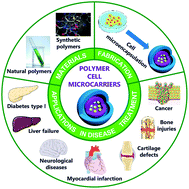当前位置:
X-MOL 学术
›
Biomater. Sci.
›
论文详情
Our official English website, www.x-mol.net, welcomes your feedback! (Note: you will need to create a separate account there.)
Polymer microcapsules and microbeads as cell carriers for in vivo biomedical applications.
Biomaterials Science ( IF 6.6 ) Pub Date : 2020-02-28 , DOI: 10.1039/c9bm01337g Barbara Kupikowska-Stobba 1 , Dorota Lewińska 1
Biomaterials Science ( IF 6.6 ) Pub Date : 2020-02-28 , DOI: 10.1039/c9bm01337g Barbara Kupikowska-Stobba 1 , Dorota Lewińska 1
Affiliation

|
Polymer microcarriers are being extensively explored as cell delivery vehicles in cell-based therapies and hybrid tissue and organ engineering. Spherical microcarriers are of particular interest due to easy fabrication and injectability. They include microbeads, composed of a porous matrix, and microcapsules, where matrix core is additionally covered with a semipermeable membrane. Microcarriers provide cell containment at implantation site and protect the cells from host immunoresponse, degradation and shear stress. Immobilized cells may be genetically altered to release a specific therapeutic product directly at the target site, eliminating side effects of systemic therapies. Cell microcarriers need to fulfil a number of extremely high standards regarding their biocompatibility, cytocompatibility, immunoisolating capacity, transport, mechanical and chemical properties. To obtain cell microcarriers of specified parameters, a wide variety of polymers, both natural and synthetic, and immobilization methods can be applied. Yet so far, only a few approaches based on cell-laden microcarriers have reached clinical trials. The main issue that still impedes progress of these systems towards clinical application is limited cell survival in vivo. Herein, we review polymer biomaterials and methods used for fabrication of cell microcarriers for in vivo biomedical applications. We describe their key limitations and modifications aiming at improvement of microcarrier in vivo performance. We also present the main applications of polymer cell microcarriers in regenerative medicine, pancreatic islet and hepatocyte transplantation and in the treatment of cancer. Lastly, we outline the main challenges in cell microimmobilization for biomedical purposes, the strategies to overcome these issues and potential future improvements in this area.
中文翻译:

聚合物微囊和微珠作为体内生物医学应用的细胞载体。
聚合物微载体已在基于细胞的治疗以及混合组织和器官工程中作为细胞传递载体而得到广泛研究。球形微载体由于易于制造和可注射性而特别受到关注。它们包括由多孔基质组成的微珠和微囊,其中基质核心另外被半透膜覆盖。微载体在植入部位提供细胞封闭,并保护细胞免受宿主免疫应答,降解和剪切应力。固定化的细胞可以进行基因改造,以直接在目标部位释放特定的治疗产品,从而消除全身疗法的副作用。细胞微载体需要在生物相容性,细胞相容性,免疫分离能力,转运,机械和化学性质。为了获得具有指定参数的细胞微载体,可以使用多种天然和合成的聚合物以及固定化方法。到目前为止,只有少数基于载有细胞的微载体的方法已经进入临床试验。仍然阻碍这些系统向临床应用发展的主要问题是体内细胞存活受限。在本文中,我们综述了用于体内生物医学应用的细胞微载体制造的聚合物生物材料和方法。我们描述了它们的主要局限性和修饰,旨在改善微载体的体内性能。我们还介绍了聚合物细胞微载体在再生医学,胰岛和肝细胞移植以及癌症治疗中的主要应用。最后,
更新日期:2020-03-19
中文翻译:

聚合物微囊和微珠作为体内生物医学应用的细胞载体。
聚合物微载体已在基于细胞的治疗以及混合组织和器官工程中作为细胞传递载体而得到广泛研究。球形微载体由于易于制造和可注射性而特别受到关注。它们包括由多孔基质组成的微珠和微囊,其中基质核心另外被半透膜覆盖。微载体在植入部位提供细胞封闭,并保护细胞免受宿主免疫应答,降解和剪切应力。固定化的细胞可以进行基因改造,以直接在目标部位释放特定的治疗产品,从而消除全身疗法的副作用。细胞微载体需要在生物相容性,细胞相容性,免疫分离能力,转运,机械和化学性质。为了获得具有指定参数的细胞微载体,可以使用多种天然和合成的聚合物以及固定化方法。到目前为止,只有少数基于载有细胞的微载体的方法已经进入临床试验。仍然阻碍这些系统向临床应用发展的主要问题是体内细胞存活受限。在本文中,我们综述了用于体内生物医学应用的细胞微载体制造的聚合物生物材料和方法。我们描述了它们的主要局限性和修饰,旨在改善微载体的体内性能。我们还介绍了聚合物细胞微载体在再生医学,胰岛和肝细胞移植以及癌症治疗中的主要应用。最后,



























 京公网安备 11010802027423号
京公网安备 11010802027423号